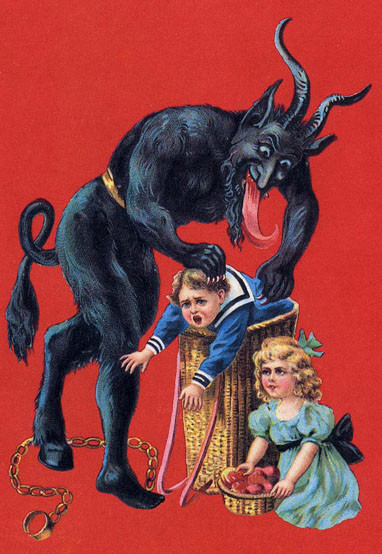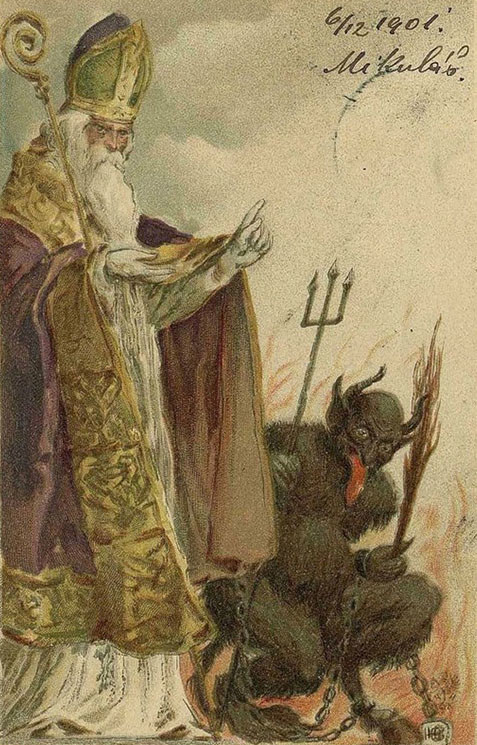
Date of Discovery
If you believe the idea that the Wild Man could, in fact, be the predecessor or most ancient embodiment of the Christmas Devil, then the first report of his existence dates back to 2000 BCE.
Name
Krampus actually goes by several different names, including Knecht Ruprecht, Certa, Perchten, Black Peter, Schmutzli, Pelznickel, and Klaubauf. There is also a record of him being referred to as the Wild Man, but it is unsure if these legends refer to Krampus himself, or Bigfoot. Krampus and Bigfoot are considered distinctly separate creatures.
The name Krampus is derived from the German word krampen which means, “claw.”
Physical Description

(St. Nicholas and Krampus)
Krampus is typically portrayed as a monstrously large, muscled, dark half-goat, half-demon, with horns, fangs, and a ridiculously long tongue. He’s seen as the anti-St. Nicholas who carries a chain with bells to announce his arrival, as well as a wicker basket or, in some cultures, a bag and bundle of birch sticks so he can mercilessly beat naughty children and then haul them to the underworld.
Origin
The origin of Krampus as he is known today relates heavily to German folklore that celebrates Krampus with a December 5th holiday celebration called Krampusnacht, where children placed their shoes out to see whether or not they have been naughty or nice. If a child had been naughty, they would receive either a rod or piece of coal, where good children would receive candies or some other type of sweet treat.
Mythology and Lore
Due to the possible spread of misinformation on the internet, it has recently been proposed that Krampus is the son of Hel, a Norse goddess of the underworld–so much so that it has appeared in articles in National Geographic and Smithsonian Magazine. That claim, however, is not necessarily as factual as it may seem–those who know Norse Mythology either have no record of this part of the mythology or vehemently rebuke the idea.
Instead, Krampus is the Christmas Devil–the evil counterpart of St. Nicholas or Santa Claus whom aside, from leaving children an indicator of their behavior throughout the year, would gather bratty and naughty children into a sack or wicker basket, beat them with the birch sticks he carried and the drag them off to hell.
It’s a popular event in countries such as Austria, Germany, Hungary, and the Czech Republic for men to dress in a Krampus costume and take part in an event called Krampuslauf. Typically this is celebrated as a sort of parade of Krampus monsters as a way to bring back old traditions.
Mythological Timeline
The people over at the Official Krampus website gave a timeline of how the mythology of the Krampus legend is believed to have evolved. There are several references that might indeed be speaking of what we now call Bigfoot, which is also referenced to the Wild Man.

2000 BCE
- In the Epic of Gilgamesh, Enkidu is considered the earliest known appearance of the Wild Man within folklore.
600 BCE
- Within the Old Testament, in the Book of Daniel, the Christian mythos tells of when God punished King Nebuchadnezzar for his pride and turned him into a hairy beast.
217 BCE
- Saturnalia, a pagan holiday within the month of December is officially introduced in Rome as the official winter celebration. It established one of the first instances of social role reversals where the slave became the master and vice versa. People would throw wild parties and give gifts to one another.
300s
- Around five hundred years after the introduction of Saturnalia to Rome, the Romans had actually converted to Christianity–with their influence, they converted many Germanic tribes to Christianity. Their pagan roots survived only in small remote villages within the Alps where the Church could not gain favor.
1250
- Konungs skuggsjá, or King’s Mirror–a historical Norwegian text in which the Wild Man appears, described as being covered in hair.
1600s
- The first appearance of Krampus as Knecht Ruprecht within the Christmas procession in Nuremberg.
Early 1800s
- When the Brothers Grimm began recording and publishing Germanic Folktales, acceptance began to be re-established within the culture. Jacob Grimm even mentioned Krampus within his Deutsche mythologie.
- Within this time postcards celebrating Krampusnacht were introduced into the culture of Austria, Germany and other parts of Europe which officially initiated the recognition of Krampus and other companions of St. Nicholas.
- When German and Dutch immigrants began to arrive in the US, they also brought the popularity of Pelznickel traditions to Pennsylvania, and Maryland which spread as far west as Indiana.
2004
- A collection of vintage Krampus postcards from the 1800s was published by Monte Beauchamp as Devil in Design. This would mark the growth of the popularity of Krampus within the English speaking world.
- The Venture Bros., an Adult Swim Network show featured Krampus during a Christmas special.
2007
- Supernatural, an American television show based on the unexplainable supernatural mythos of the world, they showcased Krampus as a diabolical monster they had to defeat.
2009
- Stephen Colbert, an American comedian, brought Krampus on to his television show The Colbert Report.
2013
- Krampus was featured twice within American television, by appearing both on Grimm and the animated television series American Dad.
2015
- The movie Krampus was released as a horror/comedy fusion.
Modern Pop-Culture References
Books & Literature
Movies
- Krampus (2015)
Television Series
- Supernatural (2005 – )
- Grimm (2011 – 2017)
Is there anything we missed about Krampus? Let us know in the comments section below!

Georgia-based author and artist, Mary has been a horror aficionado since the mid-2000s. Originally a hobby artist and writer, she found her niche in the horror industry in late 2019 and hasn’t looked back since. Mary’s evolution into a horror expert allowed her to express herself truly for the first time in her life. Now, she prides herself on indulging in the stuff of nightmares.
Mary also moonlights as a content creator across multiple social media platforms—breaking down horror tropes on YouTube, as well as playing horror games and broadcasting live digital art sessions on Twitch.
